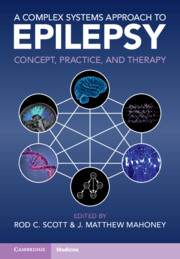Book contents
- A Complex Systems Approach to Epilepsy
- A Complex Systems Approach to Epilepsy
- Copyright page
- Contents
- Contributors
- Chapter 1 Introduction
- Chapter 2 Systems Biology Approaches to the Genetic Complexity of Epilepsy
- Chapter 3 Transcriptomic and Epigenomic Approaches for Epilepsy
- Chapter 4 Phenomenological Mesoscopic Models for Seizure Activity
- Chapter 5 Personalized Network Modeling in Epilepsy
- Chapter 6 The Baseline and Epileptiform EEG
- Chapter 7 Neuronal Approaches to Epilepsy
- Chapter 8 Mapping Epileptic Networks with Scalp and Invasive EEG
- Chapter 9 A Neuroimaging Network-Level Approach to Drug-Resistant Epilepsy
- Chapter 10 Epilepsy as a Complex Network Disorder
- Index
- References
Chapter 6 - The Baseline and Epileptiform EEG
A Complex Systems Approach
Published online by Cambridge University Press: 06 January 2023
- A Complex Systems Approach to Epilepsy
- A Complex Systems Approach to Epilepsy
- Copyright page
- Contents
- Contributors
- Chapter 1 Introduction
- Chapter 2 Systems Biology Approaches to the Genetic Complexity of Epilepsy
- Chapter 3 Transcriptomic and Epigenomic Approaches for Epilepsy
- Chapter 4 Phenomenological Mesoscopic Models for Seizure Activity
- Chapter 5 Personalized Network Modeling in Epilepsy
- Chapter 6 The Baseline and Epileptiform EEG
- Chapter 7 Neuronal Approaches to Epilepsy
- Chapter 8 Mapping Epileptic Networks with Scalp and Invasive EEG
- Chapter 9 A Neuroimaging Network-Level Approach to Drug-Resistant Epilepsy
- Chapter 10 Epilepsy as a Complex Network Disorder
- Index
- References
Summary
Many will trace the earliest articulation of what we may today call the science of complexity to Weaver’s [1] classic essay. In this work, Weaver distinguished between (i) the science of “simplicity” with phenomena that could be understood when reduced to a few variables, such as classical mechanics in two dimensions, (ii) the science of “disorganized complexity” concerning systems with large numbers of variables analyzed by a process of averaging, such as statistical thermodynamics, and (iii) an emerging field of “organized complex” systems, also with large numbers of variables, that was not amenable to either approach. This third middle region, Weaver wrote, would form the next significant challenge for science, needing both the power of machines (computers) and large interdisciplinary scientific teams for progress. Today, the field of complex systems, though lacking a universally accepted definition, studies entities – physical, biological, or social – united by the presence of large numbers of nonlinearly interacting agents that yield collective behavior not directly predictable from the laws governing interactions of the individual agents [2]. The thesis of complexity is therefore in direct opposition to the philosophy of reductionism and the source of an important debate regarding the foundations of science itself [3]. Examples of collective behavior in complex systems include, for instance, the “emergent” phenomena of macroscopic patterns [4] and phase transitions [5]. These coherent structures occur at scales far removed from those governing the interaction of the individual entities of the system and are due to bifurcation and symmetry breaking [6] involving macroscopic “collective” variables. On the other hand, the large size and nonlinearity of complex systems endow them with a measure of unpredictability – arising from deterministic chaos as well as inherent “fluctuations” – that naturally invokes a probabilistic description. Complex systems are thus said to have an “open” future that generates information and “surprise” as they evolve [7].
- Type
- Chapter
- Information
- A Complex Systems Approach to EpilepsyConcept, Practice, and Therapy, pp. 72 - 85Publisher: Cambridge University PressPrint publication year: 2023



